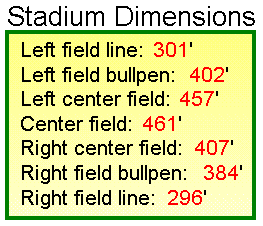ASIDE FROM the
winning tradition, Yankee Stadium, due to its vastness, was like no other
Major League ballpark. Only Mickey Mantle of the thousands who stepped to
home plate cleared the 461-foot center field wall (and typically of Mick
he did it twice: once from each side). Left center was
 just as distant:
457 feet, with right center a still intimidating 407 feet. It was down the
foul lines, 301 feet in left and 296 in right, that things got easier for
a long ball hitter. For a right handed batter like the Yankee Clipper,
“death valley” was an apt label for this ball field. Parenthetically,
during DiMaggio’s heyday and, in fact, well into Mantle’s, fans
could walk on the field after the game when leaving. The monuments to Babe
Ruth, Lou Gehrig and manager Miller Huggins, now hidden from public view,
were placed right at the 461' marker. It seemed that home plate was a mile
back, in the middle of a towering three-tiered vault.
just as distant:
457 feet, with right center a still intimidating 407 feet. It was down the
foul lines, 301 feet in left and 296 in right, that things got easier for
a long ball hitter. For a right handed batter like the Yankee Clipper,
“death valley” was an apt label for this ball field. Parenthetically,
during DiMaggio’s heyday and, in fact, well into Mantle’s, fans
could walk on the field after the game when leaving. The monuments to Babe
Ruth, Lou Gehrig and manager Miller Huggins, now hidden from public view,
were placed right at the 461' marker. It seemed that home plate was a mile
back, in the middle of a towering three-tiered vault.
Even in his too-brief career of thirteen seasons, DiMaggio would have achieved
far more offensively had he played in any other park. In 1939 an eye infection
in the last two weeks of the season plummeted his batting average from .412
to .381. Otherwise, pressure player that he was—how else account for
the 56-game hitting streak—he would surely have surpassed .400. As high
as .381 is, without doubt many a ball that was caught on the fly would have
been against the wall or over it save at Yankee Stadium. A proud but not
boastful man, when Joltin’ Joe intimated that he might have broken Babe
Ruth’s single season home run mark of 60 in 1937 but for the huge dimensions
of center and left center, it may well have been so. He had to settle for
46, the highest of any Yankee right-handed hitter before the park was remodeled.
DiMaggio may have been a better hitter than even Ted Williams, his rival
among the game’s greats at the time. The general consensus has him as
the better all-around player with Williams the better hitter. An imaginative
statistician suggested otherwise, comparing the road records of each to discover
DiMaggio’s batting average to be five points higher: .333 to .328. Had
he replaced Williams or Musial in their respective parks, the man who wore
number five on his back would easily have hit 500 home runs, probably have
attained a batting average 20 points higher than his lifetime .325, with
a lot more runs batted-in (it took thirteen seasons to garner 1537 while
Mantle, playing in eighteen, had 1509). Add three peak years lost in WW II
and it’s quite a “could-have-been!”
To return to the television metaphor, there’s no hiding the fact that
DiMaggio’s image had its distortions and imperfections. “The other
DiMaggio,” his brother Dominick was believed by many at that period
to be Joe’s superior defensively in center field. Playing with (and
compensating for) Ted Williams, Dom had 400 putouts in four of only ten seasons,
once topping 500, an accomplishment surpassed solely by Richie Ashburn among
players post-dating WW II. (An excellent lead-off type hitter who batted
a career .298 and appeared in eight all-star games, the “Little
Professor,” his nickname, now no longer enjoys much standing among the
faculty.)
Then there is Joe’s undistinguished World Series record. Beyond the
rare display of anger at Al Gionfriddo’s catch that cost him a home
run in the 1947 clash with the Dodgers, not much else comes to mind in the
ten that he played in.
Next
Back
 just as distant:
457 feet, with right center a still intimidating 407 feet. It was down the
foul lines, 301 feet in left and 296 in right, that things got easier for
a long ball hitter. For a right handed batter like the Yankee Clipper,
“death valley” was an apt label for this ball field. Parenthetically,
during DiMaggio’s heyday and, in fact, well into Mantle’s, fans
could walk on the field after the game when leaving. The monuments to Babe
Ruth, Lou Gehrig and manager Miller Huggins, now hidden from public view,
were placed right at the 461' marker. It seemed that home plate was a mile
back, in the middle of a towering three-tiered vault.
just as distant:
457 feet, with right center a still intimidating 407 feet. It was down the
foul lines, 301 feet in left and 296 in right, that things got easier for
a long ball hitter. For a right handed batter like the Yankee Clipper,
“death valley” was an apt label for this ball field. Parenthetically,
during DiMaggio’s heyday and, in fact, well into Mantle’s, fans
could walk on the field after the game when leaving. The monuments to Babe
Ruth, Lou Gehrig and manager Miller Huggins, now hidden from public view,
were placed right at the 461' marker. It seemed that home plate was a mile
back, in the middle of a towering three-tiered vault.